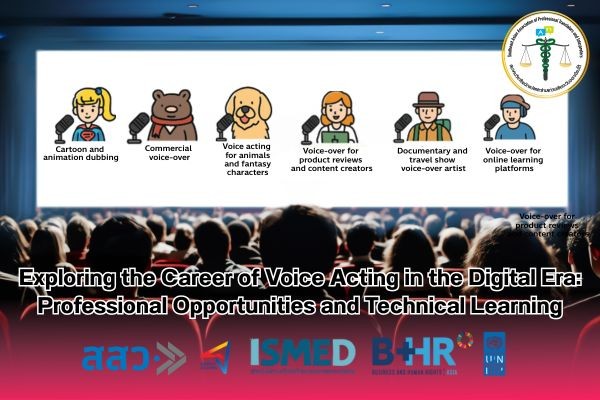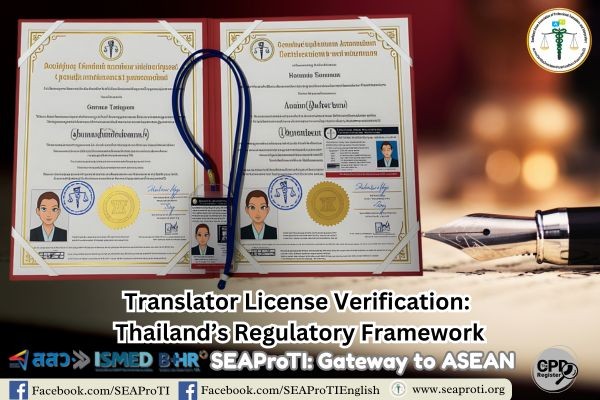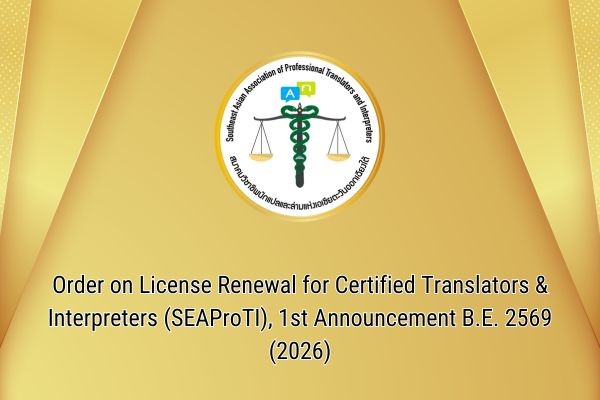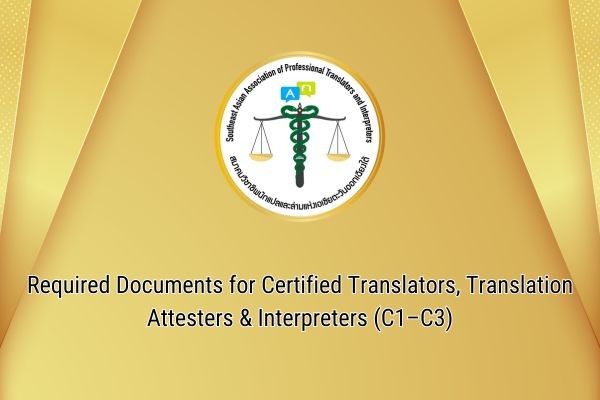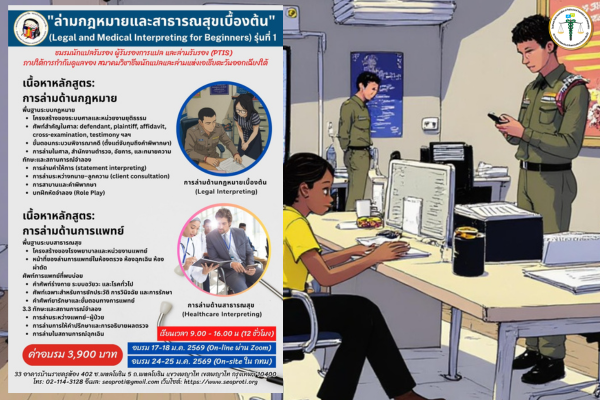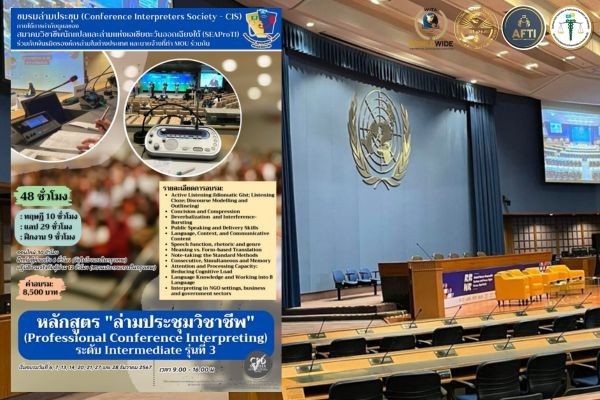Exploring the Career of Voice Acting in the Digital Era: Professional Opportunities and Technical Learning
23 July 2025, Bangkok – This article presents an overview of the voice acting profession in the digital era, which has experienced continuous growth due to the expansion of multimedia industries such as animation, gaming, online content creation, and e-learning platforms. It discusses the various career paths that can be pursued after voice acting training, essential technical skills, and strategies for building a strong personal brand in the industry. Academic references and current industry practices are included to support the discussion.
1. Introduction
In the past, voice acting was largely confined to the entertainment sector, such as cartoons and films. However, in the digital age, the scope of voice acting has expanded significantly across various platforms, including YouTube, podcasts, TikTok, e-learning, and digital advertising, all of which demand effective vocal communication (Lass & Stemple, 2021).
Voice acting is not simply about reading aloud. It involves emotional expression through voice—an art form requiring specialized skills, such as voice modulation, character voice design, and tonal adjustment to suit specific audiences (Collins & Weninger, 2020).
2. The Growing Importance of Voice Acting
The continuous rise of the online content industry has driven demand for professional voice actors (Statista, 2024). For instance, e-learning platforms require trustworthy and clear narrators, while international animation and game producers need voices that align with their target cultures.
Career paths for voice actors now include:
- Cartoon and animation dubbing
- Advertising and commercial narration
- Character voices for fantasy or animals
- Product reviews and YouTube content narration
- Documentaries and travel programs
- Voice-over for e-learning courses
These trends demonstrate that voice acting is not only a viable profession but also offers various income-generating opportunities, both full-time and freelance (Hewitt, 2022).
3. Curriculum Components of Voice Acting Training
Modern voice acting courses integrate both theory and practice. Key modules include:
- Differentiating between voice acting and voice-over
- Vocal warm-up techniques and breathing control
- Storytelling techniques for listener engagement
- Script analysis and context-driven vocal design
- Introduction to basic audio editing tools
- Portfolio creation for aspiring voice actors
- Marketing techniques for building a personal brand
These competencies help learners transition from having a “good voice” to becoming a professional in the competitive job market (Voices, 2023).
4. Career Development Techniques and Personal Branding
Successful voice actors often exhibit unique personal traits—such as recognizable voices, the ability to switch character roles seamlessly, and the use of body language while recording. Continuous practice is essential.
Key success factors include:
- Regular vocal practice: Daily voice training improves fluency and confidence
- Feedback and critique: Constructive input leads to performance improvement
- Personal branding: Building YouTube channels or hosting podcasts
- Community engagement: Joining voice acting groups on Facebook or Discord
Developing a distinctive vocal identity and consistently refining one’s technique are essential to long-term success in this field (Mason, 2021).
5. Conclusion
Voice acting is no longer merely an extracurricular hobby—it has become a credible and sustainable profession. As digital media continues to grow, acquiring technical knowledge and continuously developing skills is vital for aspiring voice actors to compete and thrive in this dynamic field.
References:
- Collins, S., & Weninger, C. (2020). Voice and Identity in Media Performance. Routledge.
- Hewitt, J. (2022). Becoming a Voice Actor: The Complete Guide to Starting Your Career. Creative Sound Studio.
- Lass, N. J., & Stemple, J. C. (2021). Fundamentals of Voice and Articulation (7th ed.). Cengage Learning.
- Mason, R. (2021). The Psychology of Voice Acting: Finding Your Character Through Voice. VoiceArt Press.
- Statista. (2024). Global voiceover industry revenue from 2019 to 2024. https://www.statista.com
- Voices. (2023). Voice Over Trends Report 2023. https://www.voices.com/company/press/reports/2023-voice-over-trends
SEAProTI’s certified translators, translation certification providers, and certified interpreters:
The Southeast Asian Association of Professional Translators and Interpreters (SEAProTI) has officially announced the criteria and qualifications for individuals to register as “Certified Translators,” “Translation Certification Providers,” and “Certified Interpreters” under the association’s regulations. These guidelines are detailed in Sections 9 and 10 of the Royal Thai Government Gazette, issued by the Secretariat of the Cabinet under the Office of the Prime Minister of the Kingdom of Thailand, dated July 25, 2024, Volume 141, Part 66 Ng, Page 100. the Royal Thai Government Gazette
การศึกษาสายอาชีพนักพากย์เสียงในยุคดิจิทัล: โอกาสทางอาชีพและการเรียนรู้เชิงเทคนิค
23 กรกฎาคม 2568, กรุงเทพมหานคร – บทความนี้นำเสนอภาพรวมของอาชีพนักพากย์เสียง (voice actor) ในยุคดิจิทัลที่มีการเติบโตอย่างต่อเนื่อง สืบเนื่องจากการขยายตัวของอุตสาหกรรมสื่อมัลติมีเดีย เช่น แอนิเมชัน เกม คอนเทนต์ออนไลน์ และแพลตฟอร์มการเรียนรู้ บทความยังกล่าวถึงประเภทงานที่สามารถต่อยอดจากการเรียนพากย์เสียง เทคนิคสำคัญในการฝึกฝน และแนวทางการสร้างอัตลักษณ์ของนักพากย์ให้เป็นที่ยอมรับในตลาดงานปัจจุบัน โดยมีการอ้างอิงจากแหล่งข้อมูลวิชาการและแนวปฏิบัติในอุตสาหกรรม
1. บทนำ
อาชีพนักพากย์เสียงในอดีตมักถูกจำกัดอยู่ในวงการบันเทิงเฉพาะ เช่น การ์ตูนหรือภาพยนตร์ แต่ในยุคดิจิทัล อาชีพนี้ได้ขยายขอบเขตไปสู่หลากหลายสื่อและแพลตฟอร์ม เช่น YouTube, Podcast, TikTok, การเรียนการสอนออนไลน์ และโฆษณาดิจิทัล ซึ่งต่างต้องการผู้ที่สามารถสื่อสารผ่านเสียงได้อย่างมีประสิทธิภาพ (Lass & Stemple, 2021)
การพากย์เสียงจึงไม่ใช่เพียงการ “อ่านออกเสียง” แต่เป็นการแสดงออกทางอารมณ์ผ่านเสียง (voice acting) ที่ต้องอาศัยทักษะเฉพาะด้าน ไม่ว่าจะเป็นการควบคุมเสียง การออกแบบเสียงให้เหมาะกับบทบาท หรือแม้กระทั่งการปรับโทนเสียงให้เข้ากับกลุ่มเป้าหมาย (Collins & Weninger, 2020)
2. ความสำคัญของอาชีพนักพากย์เสียงในยุคปัจจุบัน
การเติบโตของอุตสาหกรรมคอนเทนต์ออนไลน์ส่งผลให้อาชีพนักพากย์เสียงมีความต้องการสูงขึ้นอย่างต่อเนื่อง (Statista, 2024) ตัวอย่างเช่น แพลตฟอร์มสื่อการเรียนรู้จำเป็นต้องใช้ voice over ที่น่าเชื่อถือและเข้าใจง่าย ในขณะที่ผู้ผลิตเกมและแอนิเมชันต่างประเทศต้องการนักพากย์ที่สามารถให้เสียงสอดคล้องกับวัฒนธรรมเป้าหมาย
ประเภทงานที่นักพากย์สามารถต่อยอดได้ มีดังนี้:
- พากย์การ์ตูน / แอนิเมชัน
- พากย์โฆษณาสินค้า
- พากย์เสียงสัตว์ / ตัวละครแฟนตาซี
- พากย์รีวิว / คอนเทนต์ YouTube
- พากย์สารคดี / รายการท่องเที่ยว
Voice Over สำหรับคอร์สออนไลน์
แนวโน้มเหล่านี้ชี้ให้เห็นว่าอาชีพนักพากย์ไม่เพียงแต่มีความต้องการสูงเท่านั้น แต่ยังเปิดโอกาสให้ผู้เรียนได้สร้างรายได้จากหลากหลายช่องทาง ทั้งแบบพนักงานประจำและฟรีแลนซ์ (Hewitt, 2022)
3. เนื้อหาการเรียนรู้ในหลักสูตรพากย์เสียง
หลักสูตรพากย์เสียงในปัจจุบันครอบคลุมทั้งทฤษฎีและภาคปฏิบัติ ตัวอย่างหัวข้อสำคัญ ได้แก่:
- ความแตกต่างระหว่าง Voice Acting กับ Voice Over
- การวอร์มเสียง และการหายใจอย่างมีจังหวะ
- เทคนิคการเล่าเรื่องให้ผู้ฟัง “อิน” กับเสียง
- การอ่านสคริปต์ และออกแบบเสียงตามบริบท
- การใช้ซอฟต์แวร์ตัดต่อเสียงเบื้องต้น
- การทำ Portfolio สำหรับนักพากย์
- การตลาดสำหรับนักพากย์ยุคใหม่
การเรียนรู้เหล่านี้ช่วยให้ผู้เรียนไม่เพียงแค่ “มีเสียงดี” แต่สามารถใช้เสียงอย่างมืออาชีพในตลาดงานจริง (Voices, 2023)
4. เทคนิคการพัฒนาอาชีพและการสร้างอัตลักษณ์
นักพากย์ที่ประสบความสำเร็จมักมีจุดเด่นเฉพาะตัว เช่น เสียงจำง่าย ความสามารถในการสลับเสียงตัวละคร หรือการใช้ภาษากายร่วมกับการพากย์ ซึ่งจำเป็นต้องฝึกฝนอย่างสม่ำเสมอ
ปัจจัยที่ส่งเสริมให้นักพากย์ประสบความสำเร็จ ได้แก่:
- ความสม่ำเสมอในการฝึก: พากย์ทุกวันเพื่อพัฒนาความคุ้นเคยกับเสียง
- การรับฟัง feedback: จากอาจารย์หรือผู้ฟังเพื่อปรับปรุง
- การสร้างแบรนด์ส่วนตัว: เช่น ช่อง YouTube หรือ Podcast
- การเข้าร่วมคอมมูนิตี้: เช่นกลุ่มนักพากย์ใน Facebook หรือ Discord
การฝึกฝนและการมีอัตลักษณ์ชัดเจนคือกุญแจสำคัญที่จะทำให้เสียงของนักพากย์ “อยู่ในใจคนฟัง” ได้อย่างยั่งยืน (Mason, 2021)
5. บทสรุป
การเรียนพากย์เสียงในยุคนี้ไม่ได้เป็นเพียงกิจกรรมเสริม แต่สามารถนำไปต่อยอดเป็นอาชีพได้จริง โดยเฉพาะในยุคที่สื่อดิจิทัลเติบโตทุกวัน การมีความรู้ ความเข้าใจเชิงเทคนิค และการพัฒนาทักษะอย่างต่อเนื่อง จะช่วยให้ผู้เรียนมีศักยภาพในการแข่งขัน และสร้างรายได้ในสายงานนักพากย์เสียงได้อย่างมั่นคง
บรรณานุกรม (References)
- Collins, S., & Weninger, C. (2020). Voice and Identity in Media Performance. Routledge.
- Hewitt, J. (2022). Becoming a Voice Actor: The Complete Guide to Starting Your Career. Creative Sound Studio.
- Lass, N. J., & Stemple, J. C. (2021). Fundamentals of Voice and Articulation (7th ed.). Cengage Learning.
- Mason, R. (2021). The Psychology of Voice Acting: Finding Your Character Through Voice. VoiceArt Press.
- Statista. (2024). Global voiceover industry revenue from 2019 to 2024. https://www.statista.com
- Voices. (2023). Voice Over Trends Report 2023. https://www.voices.com/company/press/reports/2023-voice-over-trends
เกี่ยวกับนักแปลรับรอง ผู้รับรองการแปล และล่ามรับรองของสมาคมวิชาชีพนักแปลและล่ามแห่งเอเชียตะวันออกเฉียงใต้
สมาคมวิชาชีพนักแปลและล่ามแห่งเอเชียตะวันออกเฉียงใต้ (SEAProTI) ได้ประกาศหลักเกณฑ์และคุณสมบัติผู้ที่ขึ้นทะเบียนเป็น “นักแปลรับรอง (Certified Translators) และผู้รับรองการแปล (Translation Certification Providers) และล่ามรับรอง (Certified Interpreters)” ของสมาคม หมวดที่ 9 และหมวดที่ 10 ในราชกิจจานุเบกษา ของสำนักเลขาธิการคณะรัฐมนตรี ในสำนักนายกรัฐมนตรี แห่งราชอาณาจักรไทย ลงวันที่ 25 ก.ค. 2567 เล่มที่ 141 ตอนที่ 66 ง หน้า 100 อ่านฉบับเต็มได้ที่: นักแปลรับรอง ผู้รับรองการแปล และล่ามรับรอง


